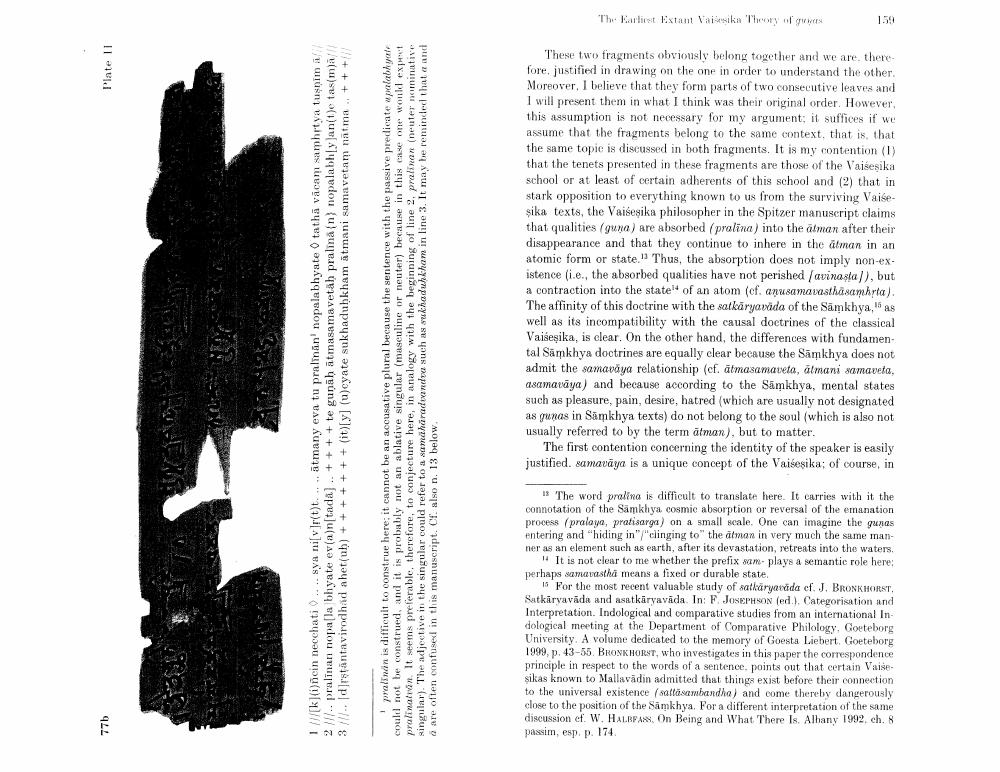________________
Plate II
77b
ABERE VOLL REN
2. pralinan nopala bhyate ev(a)n[tada].. ++++te gunah atmasamavetäḥ pralina (n) nopalabh[y]an(t)e tas(m)ã/// 1 //[k](i)ñcin necchati... sya ni[v]r(t)t. ätmany eva tu pralinan' nopalabhyate O tatha vacam samhrtya tuşṇīm a [d]rstäntavirodhad ahet(ub) +++++++ (it) [y] (u)cyate sukhaduḥkham atmani samavetam natma.. +++//
as
pralinatvan. It seems preferable, therefore, to coniecture here, in analogs with the heute because in this case one would expect true here; it cannot be an accusative plural because the sentence with the passive predicate upalabhyate singular). The adjective in the singular could refer to a samaharadvandva such sukhaduḥkham in line 3. It may be reminded that a and manuscript. Cf. also n. 13 below.
a are often confused in this
could not be
sum
The Earliest Extant Vaisesika Theory of guyas
These two fragments obviously belong together and we are, therefore, justified in drawing on the one in order to understand the other. Moreover, I believe that they form parts of two consecutive leaves and I will present them in what I think was their original order. However, this assumption is not necessary for my argument; it suffices if we assume that the fragments belong to the same context, that is, that the same topic is discussed in both fragments. It is my contention (1) that the tenets presented in these fragments are those of the Vaisesika school or at least of certain adherents of this school and (2) that in stark opposition to everything known to us from the surviving Vaiseşika texts, the Vaisesika philosopher in the Spitzer manuscript claims that qualities (guna) are absorbed (pralina) into the atman after their disappearance and that they continue to inhere in the atman in an atomic form or state." Thus, the absorption does not imply non-existence (i.e., the absorbed qualities have not perished [avinasta]), but a contraction into the state" of an atom (cf. anusamavasthasamhṛta). The affinity of this doctrine with the satkaryavada of the Samkhya, as well as its incompatibility with the causal doctrines of the classical Vaiseşika, is clear. On the other hand, the differences with fundamental Samkhya doctrines are equally clear because the Samkhya does not admit the samaväya relationship (cf. atmasamaveta, almani samaveta, asamavaya) and because according to the Samkhya, mental states such as pleasure, pain, desire, hatred (which are usually not designated as gunas in Samkhya texts) do not belong to the soul (which is also not usually referred to by the term atman), but to matter.
159
The first contention concerning the identity of the speaker is easily justified. samavāya is a unique concept of the Vaisesika; of course, in
The word pralina is difficult to translate here. It carries with it the connotation of the Samkhya cosmic absorption or reversal of the emanation process (pralaya, pratisarga) on a small scale. One can imagine the gunas entering and "hiding in"/"clinging to" the atman in very much the same manner as an element such as earth, after its devastation, retreats into the waters. It is not clear to me whether the prefix sam- plays a semantic role here: perhaps samavastha means a fixed or durable state.
15 For the most recent valuable study of satkaryavada ef. J. BRONKHORST, Satkāryavada and asatkāryavada. In: F. JOSEPHSON (ed.), Categorisation and Interpretation. Indological and comparative studies from an international Indological meeting at the Department of Comparative Philology, Goeteborg University. A volume dedicated to the memory of Goesta Liebert. Goeteborg 1999, p. 43-55. BRONKHORST, who investigates in this paper the correspondence principle in respect to the words of a sentence, points out that certain Vaisesikas known to Mallavädin admitted that things exist before their connection to the universal existence (sattasambandha) and come thereby dangerously close to the position of the Samkhya. For a different interpretation of the same discussion ef. W. HALRPASS, On Being and What There Is. Albany 1992, ch. 8 passim, esp. p. 174.




